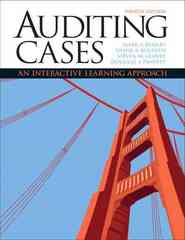Southeast Shoe Distributor (SSD) is a closely owned business founded 10 years ago by Stewart Green and
Question:
Southeast Shoe Distributor (SSD) is a closely owned business founded 10 years ago by Stewart Green and Paul Williams. SSD is a distributor that purchases and resells men’s, women’s, and children’s shoes to retail shoe stores located in small to midsize communities. The company’s basic strategy is to obtain a broad selection of designer-label and name-brand footwear at low prices to resell to small one-location retail stores. SSD targets stores that have a difficult time obtaining reasonable quantities of designer and name-brand footwear. The company is able to keep the cost of footwear low by
(1) selectively purchasing large blocks of production overruns, overorders, mid- and late-season deliveries, and last season’s stock from manufacturers and other retailers at significant discounts,
(2) sourcing in-season name-brand and branded designer footwear directly from factories in Brazil, Italy, and Spain, and (3) negotiating favorable prices with manufacturers by ordering footwear during off-peak production periods and taking delivery at one central warehouse.
During the year, the company purchased merchandise from over 50 domestic and international vendors, independent resellers, manufacturers, and other retailers that have frequent excess inventory. Designer and name-brand footwear sold by the company include the following: Amalfi, Clarks, Dexter, Fila, Florsheim, Naturalizer, and Rockport. At the present time, SSD has one warehouse located in Atlanta, Georgia. Last year, SSD had net sales of \($7\),311,214. Sales are strongest in the second and fourth calendar-year quarters, with the first calendar-year quarter substantially weaker than the rest.
BACKGROUND SSD is required to have an audit of its annual financial statements to fulfill requirements of loan agreements with financial institutions. This audit is to be completed in accordance with the AICPA professional standards for the audit of nonpublic companies. Your audit firm is in the process of completing the audit for the Fiscal 2008 financial statements in accordance with these professional standards. Jorge Hernandez, audit senior, reviewed SSD policies and procedures related to acquisitions and cash disbursements and prepared the enclosed flowcharts (referenced in the top right hand corner as E 20-1, E 20-2, and E 21) and planned control risk matrix (audit schedule E 22). As a result of this process, Jorge developed the enclosed audit program (audit schedules E 1-1 and E 1-2). The audit program was approved by Susan Mansfield, audit manager, and Katherine Smith, audit partner. The two staff auditors assigned to this engagement are Joy Avery and you. Together, you and Joy are responsible for performing the tests of transactions outlined in the expenditure cycle audit program (audit schedules El-1 and E 1-2). The general ledger accounts related to purchasing and cash disbursement activities at SSD include the following:
Inventory Purchases Purchase Discounts Purchase Returns and Allowances Freight In Administrative Expenses Warehousing Expenses Selling Expenses Prepaid Assets Accounts Payable Joy Avery has already selected the audit samples for purchases and cash disbursements and completed audit procedures 2, 3, 5, 6, and 7. Joy’s work is documented on audit schedules E 1-1, E 1 -2, E 30, E 32, E 33, E 34, E 40, E 41, E 42, E 43, and E 44.

REQUIRED
[1] Review the flowcharts on audit schedules E 20-1 and E 20-2 and become familiar with the accounting documents and records used with purchases. Also review Joy Avery’s work documented on audit schedules E 1-1, E 1-2, E 30, E 32, E 33, E 34, E 40, E 41, E 42, E 43, and E 44 in order to understand the work you will perform and how to document your work in the audit schedules. Note that purchase orders are not required to be generated for recurring services such as utilities and cleaning.
[2] Complete steps la-h from the audit program E 1-1. Assume you have already completed step lg and h and no deviations were found. Also assume that you have already tested 35 of the selected sample items, observing no misstatements. The documents and records for the remaining five sample items are provided behind the “Purchase Journal for Audit Procedure 1.” Additionally, note that the audit firm has a policy of using the same audit sample for planned tests of controls and substantive tests of transactions (dual-purpose tests) whenever possible to maximize audit efficiency Thus, the results of the test-of-controls aspect of audit steps la-h should be documented in audit schedules E 1-1 and f, 31. whereas the substantive test aspect should be documented in audit schedules E 1-1 and E 35.
[3] Complete step 4a from the audit program E1-1. Assume you have already completed this step for 55 of the 60 sample items and no deviations or misstatements were found. The documents and records for the remaining five sample items are provided behind the “Purchase Journal for Audit Procedure 4.” Document the results of your work in audit schedules EEJ. and £35.
[4] Document any adjusting entries you propose on audit schedule El 1 for any observed misstatements. You should assume that there was no systematic pattern or intent to commit a fraud based on a review and discussion with client personnel concerning observed deviations and misstatements.
Step by Step Answer:

Auditing Cases An Interactive Learning Approach
ISBN: 978-0132423502
4th Edition
Authors: Steven M Glover, Douglas F Prawitt





